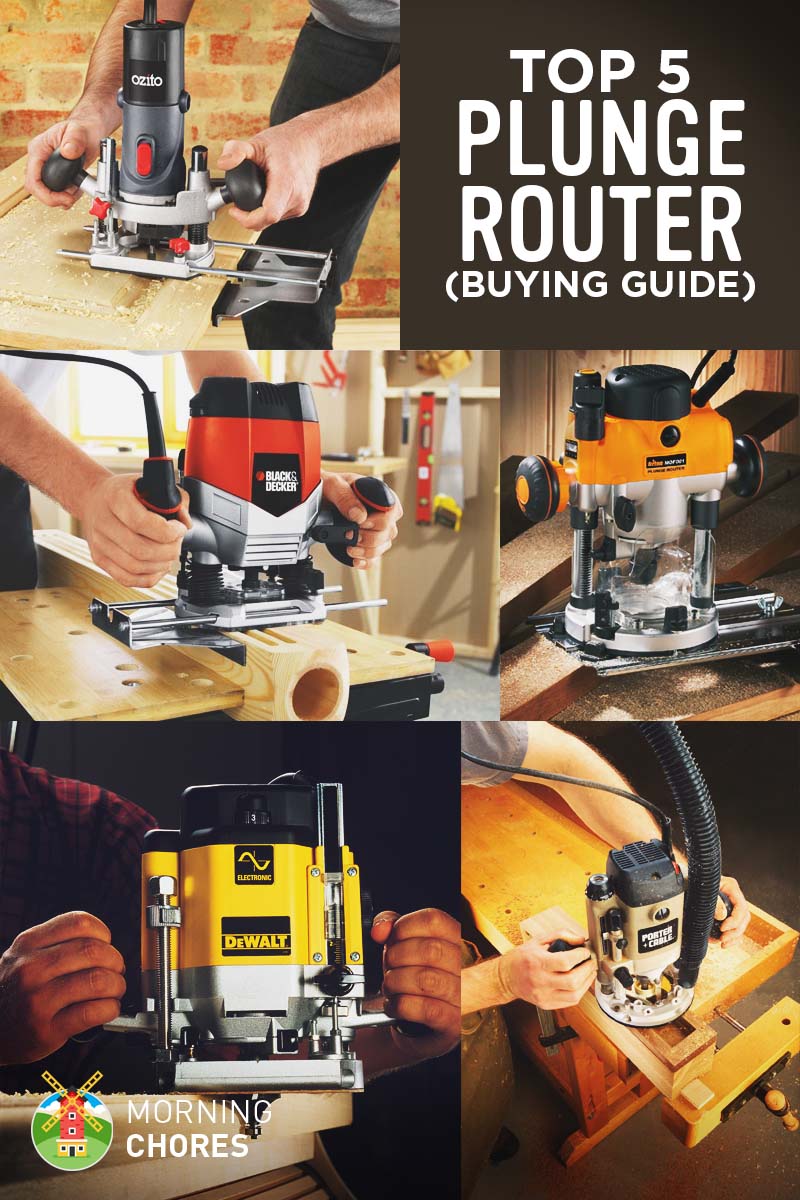For most woodworkers, even beginners, a router is one of the most essential power tools they need to have. It’s a versatile tool that can be used in many cases. But there are two problems.
First, most people don’t know whether to choose a fixed router or plunge router. Second, they don’t know which one is the best among hundreds of products on the market. Today, we’ll tackle these two problems by reviewing some of the best plunge routers you can buy.
The 5 Best Plunge Routers
- DEWALT Router Fixed/Plunge Base Kit
- Bosch Router Tool
- Triton TR001Dual Mode Precision Plunge Router
- Makita Plunge Router (Our Top Pick)
- Festool EQ Router
Our Top Pick for the Best Plunge Router
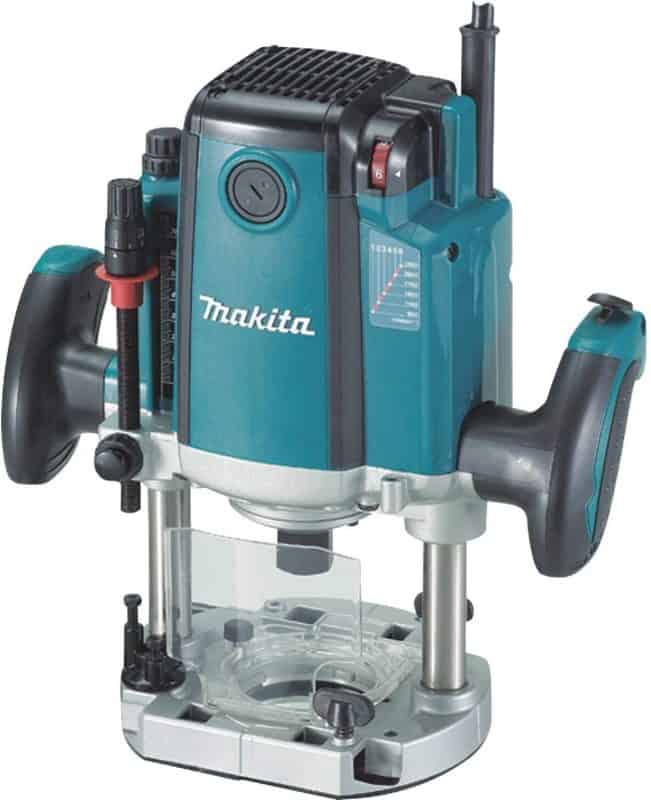
Our top pick for the best plunge router is the Makita Plunge Router.
The Makita Plunge Router is durable, strong, has huge motor power, and excellent grip. It also has all the main features that you’ll need in a router. Although it’s a little bit more expensive than other products within its class, the Makita Plunge Router is definitely worth your money.
Check the price on AmazonFixed Base vs. Plunge Router
First, you need to know the difference between fixed-base routers and plunge routers. Let’s talk in more depth about the difference and which one you actually need.
1. Fixed Base Router
With a fixed base router, the depth of the cut is set before you turn the router on. In other words, if you set a fixed base router at a cut depth of ¼”, the router bit protrudes past the base ¼” until you change the depth. The lack of a plunge mechanism tends to make these routers lighter and less expensive.
2. Plunge Router
A plunge router allows you to adjust the depth of cut while the router is turned on. This feature comes in handy when you need to make multiple passes on board, taking off a little more wood with each pass. To accurately plunge the router to the appropriate depth while in use, plunge routers have depth stops.
Plunge routers can be used to cut mortises, stopped grooves, dados, and incised letters (with special jigs). The main disadvantage compared to a fixed router is that the plunge mechanism adds weight to the router.
Deciding which one of the two is the better choice might be something impossible without knowing what you’re going to do with it, considering that both tools do the same job with minor differences that are convenient according to different opinions. However, today we are here only to discuss the plunge router and go deeper into its characteristics and the different products that will shape your experience.
For many woodworkers, a plunge router is like one of those deluxe TV remote controls that have lots of buttons and functions. Only some understand how to utilize it, and most people only use a few of them because they don’t understand their full capabilities.
What to Consider When Choosing Plunge Routers
There are three main things that you should look into while trying to buy a plunge router to make sure you get the best one, and they are as follows:
1. Your Need
Before trying to think about any other criteria in the product, you need to ask yourself what are the tasks you are going to do with your plunge router.
Depending on your needs, you will choose the most suitable product for you. If you are trying to buy a router to soften sharp edges or cut small edges off the wood – but on a small scale – then a trim router is the best choice out there. They’re small enough to stand on the edge of a board for trimming off edge banding or laminate, yet powerful enough to handle the smallest profiling bits.
Here are the advantages of trim routers:
- Compact
- Nicely appointed
- Affordable
- Easy-grip and control
- Used for cutting hinge mortises, small dadoes, and fine joinery
2. Work Strength
A mid-sized router will definitely perform better and cover more base than a trim router. We’re talking about a 1.75-2.25-HP machine that requires a two-handed operation with either a fixed-or-plunge-style base.
So if you are looking for the ideal router that will perform all the tasks you could think of, starting from typical routing tasks to moderate and large profiling cuts, dovetailing, and mortising, then the best device for you would be a mid-sized machine. For all-around woodworking, a mid-sized router is the workhorse of both serious hobbyists and professional shops.
Plunge routers are equipped with a depth stop system so you can step off a series of cuts to create a deep mortise or cut-out. The depth stop can also help you reset the tool to the same cutting depth without measuring, making it ideal for repetitive cutting situations.
For all practical purposes, a plunge router can do everything a fixed-base router can do, but the handles and motor are mounted higher up on the base to facilitate the plunging motion.
The higher center of gravity can feel a bit unstable, especially when you’re milling small or narrow stock.
Our post on router table plans gives you a variety of options on how to use and install your brand new router.
3. Size
The rule that claims “bigger is always better” does not imply for routers, especially if you are going to use the machine as a handheld tool instead of using it on a table.
Although useful, unless you plan to use really large profiling bits or raise panels for cabinet doors, a full-sized router is more machine than you’ll ever need for ordinary profiling and joint-making. That extra weight, size, and power can even work against you on smaller or delicate work.
Still, if your budget will allow it, a 3 or 3.25-HP router will give your router table the gumption only exceeded by a shaper. It’s an investment that can easily wait for a while until you get serious about heavy-duty jobs.
With that said, once you step up to a big router, there are many good fixed-base or plunge models to choose from.
Router Features to Look At When Purchasing
On the other hand, there are a few features that could or could not be on your plunge router which mainly depends on the product you picked. They could be smart and professional enough to include the features with better quality, or just sending out a product for the sake of the sale.
Here is a detailed explanation of each feature that will make your choice even easier:
1. Variable Speed
Variable speeds on your router is an important attribute that you should have at any cost. It gives you the option to have different speeds, each achieving a different task with different accuracy. Small bits cut most cleanly at mid to high speeds, and large bits need to be dialed down to slower speeds to be used safely. With variable speed, just twist the dial one way or the other and you’re covered, no matter what bit you need to use.
2. Electronic Feedback Circuitry
This is a feature that will help maintain the durability of your device and sustain its efficiency. It basically means to measure the load to balance it with the output torque. So during a heavy cut, the motor won’t labor or stall, and power output still feels the same. Electronic feedback circuitry is a feature you won’t truly appreciate unless you’ve used an older router without this sophisticated circuitry.
With EFC, you can really focus your attention on the technique and how your cut is progressing and let the router keep pace with you.
3. Soft Start
Without the soft start, your router will blast up to full speed the second you turn it on. The noise can be startling, and that surge of power might even make the router jerk in your hands, especially with a big bit in the chuck. It’s not a pleasant way to ease into a tricky cut or get over your trepidations about routing in general.
With the soft start, you’ll experience a moment of pause after powering it up, and then the router gently accelerates to the preset speed. The soft-start feature comes standard with most new routers that have electronic feedback circuitry. It’s a subtle but pleasant feature to have on a handheld router.
4. Spindle Lock
Many routers require two wrenches for making bit changes. One wrench holds the motor shaft, and the other wrench loosens or tightens the collet. With a spindle lock, you push a spring-loaded pin or engage a locking collar to hold the motor shaft in place, so the only wrench you need is the one for the collet.
This is a particularly handy detail on dedicated plunge routers where you can’t remove the motor to get better access to the bit. It’s not a do-or-die feature, but it does take a little hassle and knuckle-busting out of the bit changing the equation.
5. Above the Table Adjustment
If you are like most woodworkers, sooner or later one of your routers will spend its days hanging under a router table. Two relatively new features can make table routing more precise and convenient.
First, buy a router that allows you to adjust the cutting height from above the table with a handle, crank, or knob. It sure beats stooping over to tweak the depth setting from underneath. Second, look for a router designed to extend the collet above the table so you can change bits without lifting out the machine. Machines with ATA will generally include both of these great enhancements.
Now that you have identified the best features and characteristics that you are looking for, here is the part where you get to know the products in the market and reach your final decision. Try to check every product thoroughly and read more about them to ensure you found what you are looking for.
5 Best Plunge Routers – Reviews
1. DEWALT Router Fixed/Plunge Base Kit
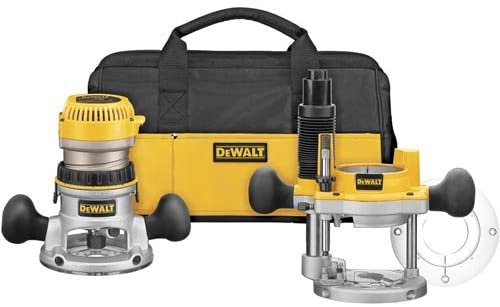
The DEWALT Router Fixed/Plunge Base Kit is definitely a very good contender for the number one position on the list.
It is a durable woodworking tool that fully utilizes the power of its 8,000-24,000 RPM to perform the toughest tasks. User-friendly features include a micro-fine depth adjustment ring that allows for precise depth adjustments, comfortable rubber over-molded handles, and a well-balanced design.
Pros
- Ideal for tough tasks
- Very accurate
- Durable
- Comfortable handles and a well-balanced design
Cons
- Not ideal for professional woodworking tasks
2. Bosch Router Tool
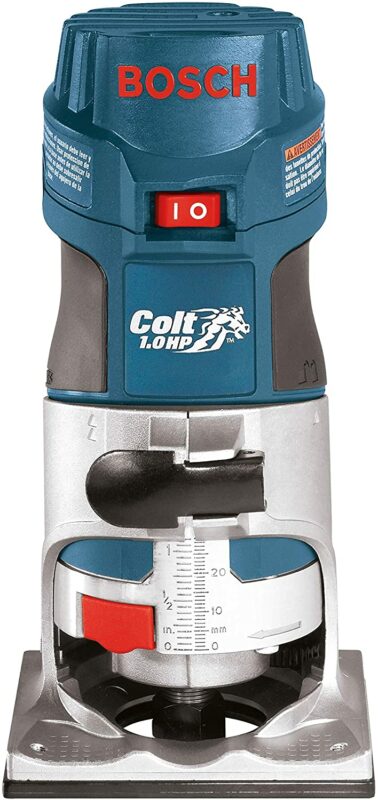
BOSCH is a strong and credible name when it comes to these types of tools.
It looks kind of different from a regular router but is still as effective. It has a 5.6 Amp motor, a wider range of speeds for your convenience. This offer specially contains more items that you might find useful. A few tools that will give you the best experience with the wood you own.
Pros
- Lightweight
- Affordable
- Good for its price
Cons
- Hard to setup
- Can be hard to control
3. Triton TRA001 Dual Mode Precision Plunge Router
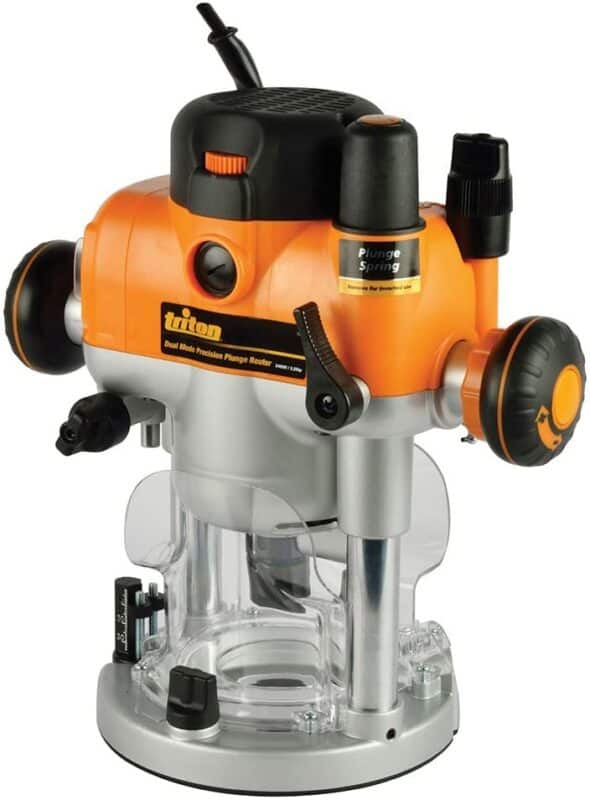
The Triton TR001 Dual Mode Precision Plunge Router offers you amazing accuracy and lots of versatility.
Its powerful, soft-start 3¼ HP motor delivers super-fast variable speeds from 8000-21000 RPM and eliminates kickback. The Micro Winder provides continuous fine depth adjustment in full plunge mode. At the press of a button, the TRA001 switches from a conventional plunge to a fixed-base router and allows for a rack and pinion adjustment.
Pros
- Amazingly accurate
- Versatile
- Powerful motor provides super-fast variable speeds
Cons
- Heavy to hold
- Some plastic parts are not very durable
4. Makita Plunge Router

This Makita Plunge Router is one of the most popular ones out there.
It might be a little more expensive than a typical router but this one defines “you get what you pay for”. It has one of the largest ranges of speeds with a quick-release cam button for depth adjustment. While looking for the right product for you, this one, in particular, should always be an option in mind.
Pros
- Accurate
- Extremely durable
- Reliable for different type of tasks
- Huge motor power
- Easy to control
- Low power consumption (for its class)
Cons
- Expensive (but worth it)
- Hard to set up
5. Festool EQ Router

The Festool EQ Router has everything you’re looking for in a plunge router.
It will easily complete a woodworking task as efficiently as possible with the best accuracy and a smooth clean surface. Using the Festool is like having a woodmaster right at your home. Buying this router is a good investment as its long-term durability means it can perform even the toughest of tasks.
Pros
- Versatile: Can be used for all kinds of woodworking tasks
- Durable
- Efficient and accurate
- Creates a smooth clean surface
Cons
- Expensive
- Not for beginners, can be too complex
Our Top Pick for the Best Plunge Router

Our top pick for the best plunge router is the Makita Plunge Router.
The Makita Plunge Router is durable, strong, has huge motor power, and excellent grip. It also has all the main features that you’ll need in a router. Although it’s a little bit more expensive than other products within its class, the Makita Plunge Router is definitely worth your money.
Check the price on Amazon